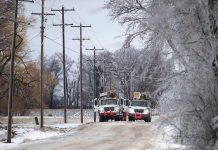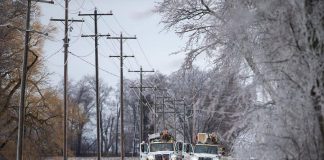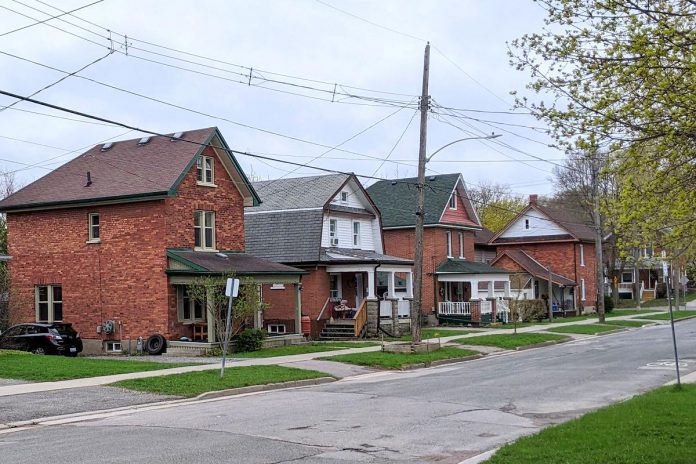
With the heating season almost at a close, it’s a good time to take stock of your home’s energy use. How much electricity did you use over the winter? What about natural gas, propane, or fuel oil? Do you know how much greenhouse gas your home emitted this winter?
A new community greenhouse gas emissions inventory was recently completed by staff at the City of Peterborough. This inventory gives a more elaborate picture of what actions we must do as a community to meet our climate targets.
As of 2021, our homes have contributed to 23 per cent of Peterborough-Nogojiwanong’s total greenhouse gas emissions. Our homes account for 114,779 metric tons of CO2 annually. Locally, only on-road transportation emits more.
Emissions from the residential sector have decreased by about 12,500 metric tons from 2011 levels, but residential emissions still need to go down by about 45,000 additional metric tons of CO2 to meet the 2030 climate target. This means a reduction of over two metric tons of CO2 for every single detached or semi-detached home in Peterborough.
The good news is that there is a tremendous opportunity for homeowners to save energy and reduce greenhouse gas emissions.
In our area, 82 per cent of homes were built over 30 years ago, when there were less stringent building codes. Simple retrofits like topping up attic insulation can reduce a home’s emissions by 10 per cent or more.

However, to meet these ambitious targets, we’ll need to do more than what simple retrofits can offer. Most homes in Peterborough emit between five and eight metric tons of CO2 annually, depending on age, insulation levels, and heating type.
To meet our targets, many homes will need to conduct deep retrofits. A deep retrofit will reduce energy use by 50 per cent or more.
“The latest community greenhouse gas inventory revealed the extent of emissions produced by housing in Peterborough,” says Peterborough city councillor Joy Lachica, chair of the city’s environment and climate change portfolio. “Deep energy retrofits are needed to lower the energy demand of homes.”
Deep retrofits consist of three elements: improving the building envelope, updating mechanical systems, and adding renewable energy.
“As a homeowner, a deep energy retrofit can improve the comfort, durability, and indoor health of your home, while lowering maintenance and monthly utility costs,” says Eric Ta, energy coordinator at Green Communities Canada, a national non-profit working to expand deep retrofits in Canada. “Deep energy retrofits will increase the overall future value of your home.”
A deep retrofit first focuses on improving the building envelope. This means adding insulation to attics as well as to walls, sloped ceilings, and basements. Improving the envelope also means making the home more airtight, so that less warm air is leaking to the outside in winter. To do this, you repair or replace windows, weatherstrip doors, and seal up cracks and holes in the building.
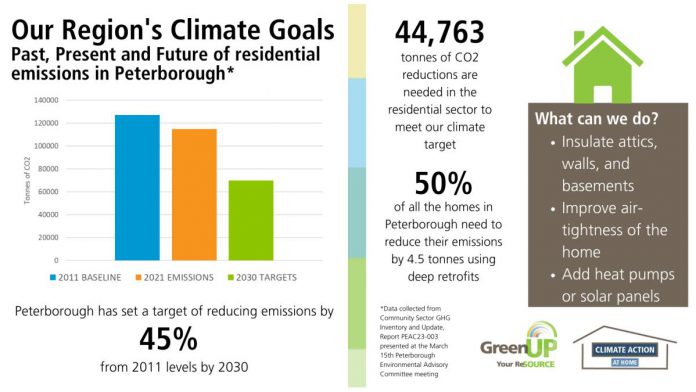
Alex Joseph, senior manager of deep energy retrofits with Green Communities Canada, explains the next two steps of a deep retrofit.
“Once your building envelope is airtight and insulated, then the mechanical system can be upgraded. The added benefit is that these systems can be smaller due to the reduced heating and cooling load. Consider adding solar to your roof or yard where space exists. Solar systems are modular and can be added in stages and installed and connected as funding permits.”
Electric air-source heat pumps are a popular choice for many homeowners that wish to upgrade their mechanical systems. A heat pump can drastically reduce a home’s emissions from heating and cooling and is the most efficient choice for heating your water.
If you’re thinking about undertaking a deep retrofit on your home, there are supports available.
The Home Efficiency Rebate Plus program offers grants up to $10,000 for Enbridge customers (up to $5,000 for non-Enbridge customers) to install measures such as insulation, air sealing, heat pumps, and solar panels. The federal government’s Canada Greener Homes Loan offers a $40,000 interest-free loan to further assist with upgrades.
In addition, the City of Peterborough is in the process of developing the Home Energy Efficiency Program, which will provide additional low-interest loans to support deep retrofits.
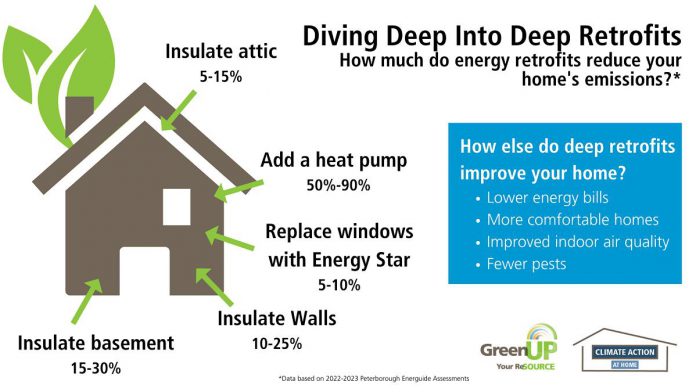
GreenUP believes that these programs, and the homeowners who choose to undertake deep retrofits, are exactly the type of leadership we need to reduce our residential emissions.
“The Home Energy Efficiency Program will help guide homeowners through the renovation journey and direct them to select third-party financing or property tax repayment methods to fund the retrofit,” Lachicha says.
“Once launched, the program can support many Peterborough homeowners to access capital to undertake extensive energy renovations that will lower utility costs and greenhouse gas emissions.”
To be eligible for any of these programs, the first step is to book an EnerGuide home energy assessment with GreenUP. A registered energy advisor will assess your home’s energy use, perform a blower door test, and provide recommendations for how best to upgrade your home to reduce energy and emissions.
Over the next several months, GreenUP will be covering the elements of deep retrofits in greater detail online, over the news, and with engaging webinars.
Learn more about the need for deep retrofits in the Peterborough-Nogojiwanong area at GreenUP’s upcoming “Your Home, Made Energy Efficient – Deep Retrofits” webinar from 12:15 to 1 p.m. on Friday, May 12th.


